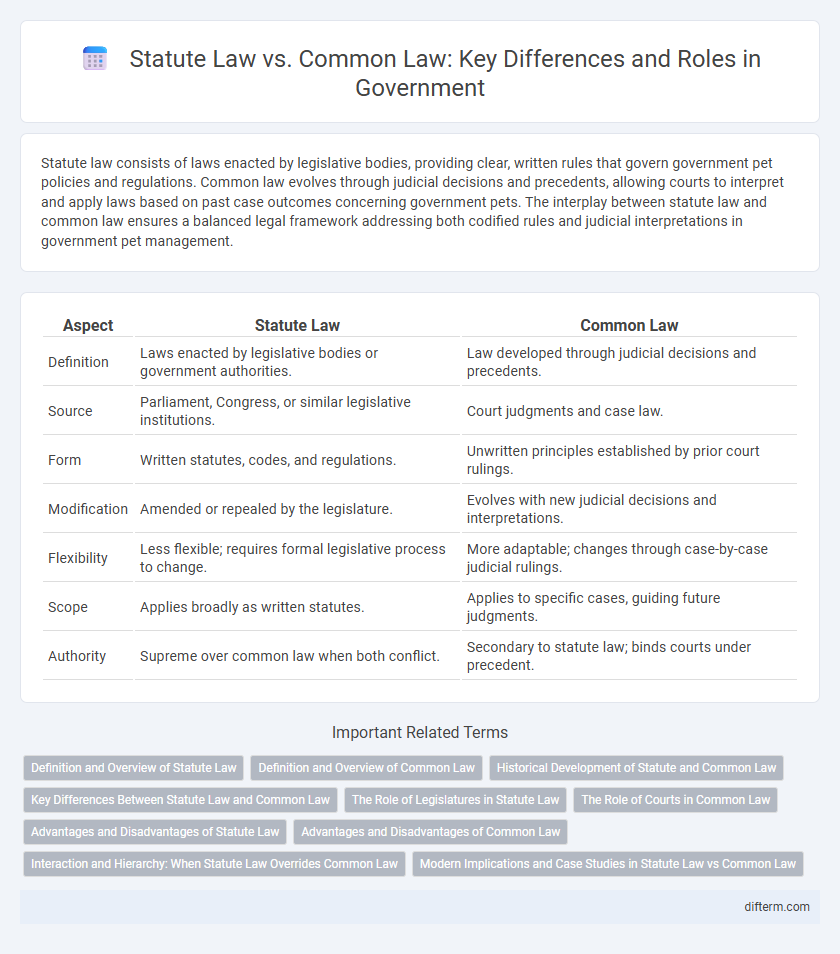Statute law consists of laws enacted by legislative bodies, providing clear, written rules that govern government pet policies and regulations. Common law evolves through judicial decisions and precedents, allowing courts to interpret and apply laws based on past case outcomes concerning government pets. The interplay between statute law and common law ensures a balanced legal framework addressing both codified rules and judicial interpretations in government pet management.
Table of Comparison
| Aspect | Statute Law | Common Law |
|---|---|---|
| Definition | Laws enacted by legislative bodies or government authorities. | Law developed through judicial decisions and precedents. |
| Source | Parliament, Congress, or similar legislative institutions. | Court judgments and case law. |
| Form | Written statutes, codes, and regulations. | Unwritten principles established by prior court rulings. |
| Modification | Amended or repealed by the legislature. | Evolves with new judicial decisions and interpretations. |
| Flexibility | Less flexible; requires formal legislative process to change. | More adaptable; changes through case-by-case judicial rulings. |
| Scope | Applies broadly as written statutes. | Applies to specific cases, guiding future judgments. |
| Authority | Supreme over common law when both conflict. | Secondary to statute law; binds courts under precedent. |
Definition and Overview of Statute Law
Statute law refers to laws formally enacted by legislative bodies such as parliaments or congresses, serving as written statutes or codes that govern legal matters. It provides a clear and structured framework, offering specific rules and regulations applicable across jurisdictions. Unlike common law, which evolves through judicial decisions and precedents, statute law is explicitly drafted and codified to ensure consistency and clarity in legal interpretation.
Definition and Overview of Common Law
Common law is a body of law developed through judicial decisions and precedents rather than legislative statutes. It evolves based on court rulings and judicial interpretations, providing a flexible legal framework that adapts to new situations. Unlike statute law, which is codified and enacted by legislatures, common law relies on the principle of stare decisis, ensuring consistent application of legal principles over time.
Historical Development of Statute and Common Law
Statute law emerged through formal legislative processes, codifying rules that reflect evolving societal norms and governmental authority, while common law developed from judicial decisions and customary practices rooted in medieval England. Statute law's historical growth accelerated with the rise of parliamentary power, providing clearer, written laws, whereas common law evolved gradually through court rulings, emphasizing precedents and judicial interpretation. The interplay between these systems shaped modern legal frameworks by balancing legislative mandates with case-based adaptability.
Key Differences Between Statute Law and Common Law
Statute law consists of written laws formally enacted by legislative bodies, providing clear, codified rules applicable across jurisdictions. Common law evolves through judicial decisions and precedents established by courts, allowing flexibility and adaptation to new circumstances. Key differences include the source of authority, with statute law derived from legislatures and common law from judicial rulings, and the scope of application, as statute law is explicit and systematic, while common law relies on interpretive judgments.
The Role of Legislatures in Statute Law
Legislatures play a fundamental role in statute law by enacting formal laws that provide clear, written rules to govern society. These statutory laws serve as the primary legal authority, superseding common law where conflicts arise. Through legislative processes, statutes address emerging social issues with precision, ensuring legal certainty and adaptability within the governmental framework.
The Role of Courts in Common Law
Courts in common law systems interpret and apply legal principles through judicial decisions that create binding precedents, known as case law, shaping the legal framework dynamically. Judicial rulings fill gaps where statute law is silent or ambiguous, ensuring laws evolve with societal changes. This role of courts contrasts with statute law, which is established by legislative bodies and relies on codified statutes rather than judicial interpretation.
Advantages and Disadvantages of Statute Law
Statute law provides clear, codified rules enacted by legislatures, offering predictability and uniformity in legal interpretation, which benefits government transparency and consistency. However, statute law can be inflexible, struggling to adapt quickly to new social issues or technological advancements without legislative amendments. Its reliance on formal legislative processes may result in slower responses to emerging legal needs compared to the more adaptable common law system.
Advantages and Disadvantages of Common Law
Common law offers flexibility by evolving through judicial decisions, allowing courts to adapt legal principles to new situations without waiting for legislative updates. This system enables consistency through precedents, promoting predictability in legal outcomes but can also result in slower legal development due to reliance on case law interpretation. However, common law's dependence on judicial decisions sometimes leads to complexity and unpredictability, with varying interpretations across different jurisdictions.
Interaction and Hierarchy: When Statute Law Overrides Common Law
Statute law holds supremacy over common law by codifying rules that courts must follow, effectively overriding conflicting judicial precedents. Courts interpret statutes in light of common law principles, but when conflicts arise, statutory provisions take precedence, ensuring legislative intent governs legal outcomes. This hierarchical relationship maintains legal consistency and reflects democratic authority through enacted legislation.
Modern Implications and Case Studies in Statute Law vs Common Law
Modern implications of statute law versus common law reveal ongoing tensions in legal interpretation and application, particularly in constitutional and administrative contexts. Case studies such as Chevron U.S.A., Inc. v. Natural Resources Defense Council, Inc. highlight judicial deference to statutory interpretation, while landmark rulings like Marbury v. Madison emphasize judicial review within common law principles. These examples demonstrate the dynamic interplay between codified legislation and judicial precedent in shaping contemporary governance and legal accountability.
Statute Law vs Common Law Infographic

 difterm.com
difterm.com